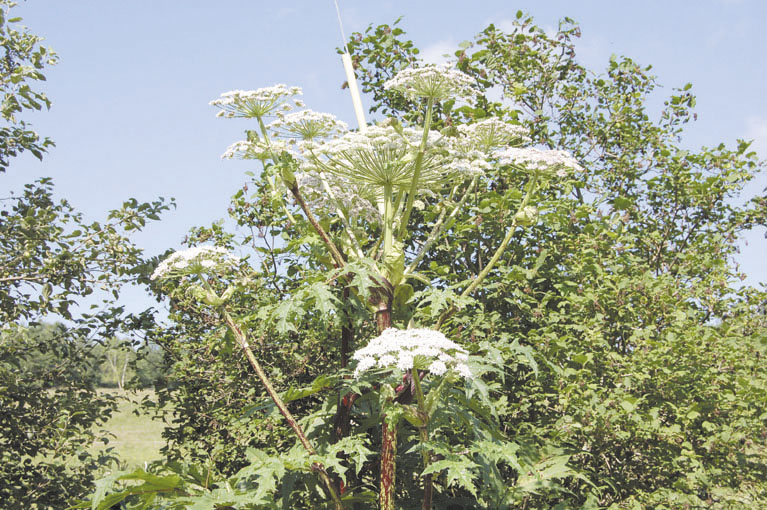State Horticulturist Ann Gibbs describes the plant as Queen Anne’s lace on steroids.
Since news reports earlier this month about an effort in New York state to control giant hogweed, Gibbs has gotten about two dozen calls and emails from Maine residents reporting sightings of the plant, which can grow up to 14 feet tall with flower heads that are a foot in diameter.
The plant is the target of eradication efforts because its sap can cause severe skin and eye irritation, painful blistering, permanent scarring and in rare cases, blindness, according to the New York state Department of Conservation. The skin usually comes in contact with the sap either through brushing against the bristles on the stem or breaking the stem or leaves.
In Maine, the new reports of the federal noxious plant have led to the confirmation of four previously undocumented giant hogweed sites, including one on Albion Road in Windham.
Henri Brady first spotted the Windham plants about a month ago, when he and his wife, Amy, were driving from their home on nearby Davis Avenue.
A week later, he was reading an online report of a poisonous plant that can cause blisters and looked at the pictures posted with the story.
“I said, ‘Wow. That’s the plant we have off Albion Road,'” Brady said.
The three other recently confirmed sites are in Sebago, Northport and Lisbon Falls. Other sightings this month either duplicated previous reports or were false alarms.
Giant hogweed is often mistaken for other less toxic plants, including cow parsnip and angelica, Gibbs said.
She has been keeping track of the plant’s presence in Maine since about 2002, when the Department of Agriculture’s Division of Plant Industry did a survey in search of giant hogweed sites and learned about most of the 21 locations that the state is aware of today.
Since then, Gibbs said she’s gotten about five reports a year, which have led to few new confirmed sites.
At the different locations in the state, the number of plants range from a couple to nearly 100, Gibbs said.
She said almost half of the sites are in Hancock County, near Mount Desert Island. By researching the history of the land, residents there determined that giant hogweed was first planted by a local landscape gardener who shared the plants with relatives and friends.
Native to the Caucasus Mountains in Russia, giant hogweed was first planted on estates in America in the early 1900s, when people were looking for something different for their gardens, Gibbs said.
Compared with New York, where there are nearly 1,000 giant hogweed sites, Maine’s problem is relatively minor.
The Department of Agriculture doesn’t have the funding for a program to control giant hogweed, so Gibbs is just trying to let people know how to get rid of the plants on their property.
Although it’s best to cut down in the early spring, Gibbs said it can help to cut the flower heads before they go to seed, which is happening about this time of year.
If there are just a few plants, property owners can cut them from the root. Otherwise, herbicides can be effective. In general, though, it’s a difficult plant to get rid of, Gibbs said.
“The really important thing about hogweed is you have to keep at it,” she said. “You think you’ve taken care of it, but there’s new plants that come up the next year.”
Brady said he thinks the plant is spreading around the Albion Road area and expects to see more of it next year. That wouldn’t bother his four kids, who have been on the lookout for giant hogweed wherever they go.
“They just think it’s cool,” he said.
Send questions/comments to the editors.




Comments are no longer available on this story